
Maasai Mara, also sometimes spelled Masai Mara and locally known simply as The Mara, is a large national game reserve in Narok, Kenya, contiguous with the Serengeti National Park in Tanzania. It is named in honour of the Maasai people, the ancestral inhabitants of the area, who migrated to the area from the Nile Basin. Their description of the area when looked at from afar: "Mara" means "spotted" in the local Maasai language, because of the short bushy trees which dot the landscape.
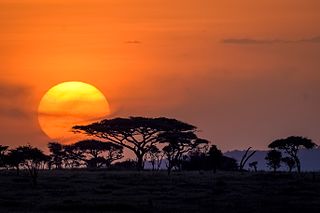
The Serengeti ecosystem is a geographical region in Africa, spanning the Mara and Arusha Regions of Tanzania. The protected area within the region includes approximately 30,000 km2 (12,000 sq mi) of land, including the Serengeti National Park and several game reserves. The Serengeti hosts the second largest terrestrial mammal migration in the world, which helps secure it as one of the Seven Natural Wonders of Africa.

Wildebeest, also called gnu, are antelopes of the genus Connochaetes and native to Eastern and Southern Africa. They belong to the family Bovidae, which includes true antelopes, cattle, goats, sheep, and other even-toed horned ungulates. There are two species of wildebeest: the black wildebeest or white-tailed gnu, and the blue wildebeest or brindled gnu.

The lion is a large cat of the genus Panthera, native to Africa and India. It has a muscular, broad-chested body; a short, rounded head; round ears; and a hairy tuft at the end of its tail. It is sexually dimorphic; adult male lions are larger than females and have a prominent mane. It is a social species, forming groups called prides. A lion's pride consists of a few adult males, related females, and cubs. Groups of female lions usually hunt together, preying mostly on large ungulates. The lion is an apex and keystone predator; although some lions scavenge when opportunities occur and have been known to hunt humans, lions typically do not actively seek out and prey on humans.

The Serengeti National Park is a large national park in northern Tanzania that stretches over 14,763 km2 (5,700 sq mi). It is located in eastern Mara Region and northeastern Simiyu Region and contains over 1,500,000 hectares of virgin savanna. The park was established in 1940.

Canine distemper virus (CDV) is a viral disease that affects a wide variety of mammal families, including domestic and wild species of dogs, coyotes, foxes, pandas, wolves, ferrets, skunks, raccoons, and felines, as well as pinnipeds, some primates, and a variety of other species. CDV does not affect humans.

Ngorongoro Conservation Area is a protected area and a UNESCO World Heritage Site located in Ngorongoro District, 180 km (110 mi) west of Arusha City in Arusha Region, within the Crater Highlands geological area of northeastern Tanzania. The area is named after Ngorongoro Crater, a large volcanic caldera within the area. The Ngorongoro Conservation Area Authority administers the conservation area, an arm of the Tanzanian government, and its boundaries follow the boundary of the Ngorongoro District in Arusha Region. The western portion of the park abuts the Serengeti National Park, and the area comprising the two parks and Kenya's Maasai Mara game reserve is home to Great Migration, a massive annual migration of millions of wildebeest, zebras, gazelles, and other animals. The conservation area also contains Olduvai Gorge, one of the most important paleoanthropological sites in the world.

Robert Morris Sapolsky is an American neuroendocrinology researcher and author. He is a professor of biology, neurology, neurological sciences, and neurosurgery at Stanford University. He is also a research associate at the National Museums of Kenya.

Thomson's gazelle is one of the best known species of gazelles. It is named after explorer Joseph Thomson and is sometimes referred to as a "tommie". It is considered by some to be a subspecies of the red-fronted gazelle and was formerly considered a member of the genus Gazella within the subgenus Eudorcas, before Eudorcas was elevated to genus status.
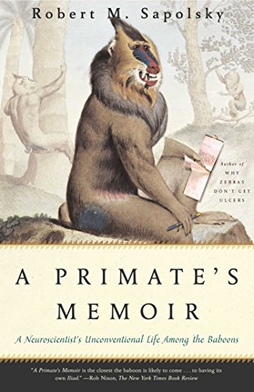
A Primate's Memoir: A Neuroscientist's Unconventional Life Among the Baboons is a 2001 book by the American biologist Robert Sapolsky. The book documents Sapolsky's years in Kenya studying baboons as a graduate student. The chapters alternate between describing observations of a troop of baboons and the wildly different culture in Africa that he is increasingly cognizant of. The book portrays an unconventional way of studying neurophysiology to determine the effects of stress on life expectancy.
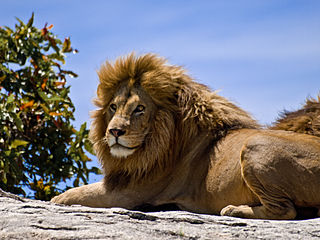
Panthera leo melanochaita is a lion subspecies in Southern and East Africa. In this part of Africa, lion populations are regionally extinct in Lesotho, Djibouti and Eritrea, and are threatened by loss of habitat and prey base, killing by local people in retaliation for loss of livestock, and in several countries also by trophy hunting. Since the turn of the 21st century, lion populations in intensively managed protected areas in Botswana, Namibia, South Africa and Zimbabwe have increased, but declined in East African range countries. In 2005, a Lion Conservation Strategy was developed for East and Southern Africa.
Barbara Boardman Smuts is an American anthropologist and psychologist noted for her research into baboons, dolphins, and chimpanzees, and a Professor Emeritus at University of Michigan, Ann Arbor.

Baboons are primates comprising the genus Papio, one of the 23 genera of Old World monkeys, in the family Cercopithecidae. There are six species of baboon: the hamadryas baboon, the Guinea baboon, the olive baboon, the yellow baboon, the Kinda baboon and the chacma baboon. Each species is native to one of six areas of Africa and the hamadryas baboon is also native to part of the Arabian Peninsula. Baboons are among the largest non-hominoid primates and have existed for at least two million years.

George Beals Schaller is an American mammalogist, biologist, conservationist and author. Schaller is recognized by many as the world's preeminent field biologist, studying wildlife throughout Africa, Asia and South America. Born in Berlin, Schaller grew up in Germany, but moved to Missouri as a teen. He is vice president of Panthera Corporation and serves as chairman of their Cat Advisory Council. Schaller is also a senior conservationist at the Bronx Zoo-based Wildlife Conservation Society.

Sarah Cleaveland is a veterinary surgeon and Professor of Comparative Epidemiology at the University of Glasgow.
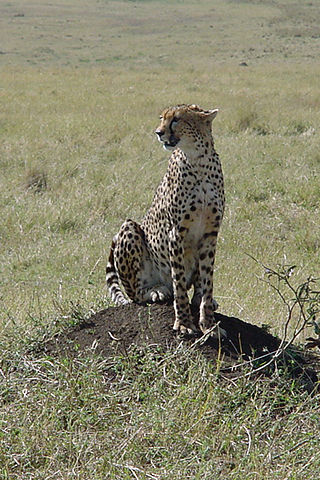
The East African cheetah, is a cheetah population in East Africa. It lives in grasslands and savannas of Tanzania, Kenya, Uganda and Somalia. The cheetah inhabits mainly the Serengeti ecosystem, including Maasai Mara, and the Tsavo landscape.
Anne Elizabeth Pusey is director of the Jane Goodall Institute Research Center and a professor of evolutionary anthropology at Duke University. Since the early 1990s, Pusey has been archiving the data collected from the Gombe chimpanzee project. The collection housed at Duke University consists of a computerized database that Pusey oversees. In addition to archiving Jane Goodall’s research from Gombe, she is involved in field study and advising students at Gombe. She was elected a member of the National Academy of Sciences in 2022.
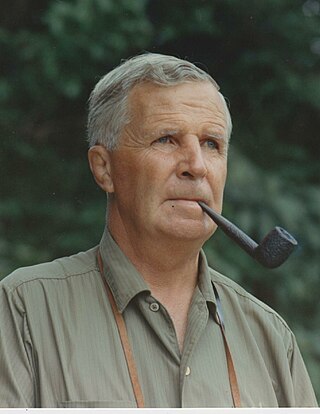
John Simpson Owen was a Ugandan-born British conservationist who served as Director of the Tanzania National Parks from 1960 to 1972, during which time he was responsible for the establishment and management a network of National Parks, the Promotion of Scientific Research as a basis for conservation and wildlife tourism in the Serengeti National Park. He was awarded the World Wildlife Fund Gold Medal in 1973 for this and its contribution to the economy of a developing country. He was also the recipient of the Order of the Golden Arc from Prince Bernhard of the Netherlands.
Dorothy Leavitt Cheney was an American scientist who studied the social behavior, communication, and cognition of wild primates in their natural habitat. She was Professor of Biology at the University of Pennsylvania and a member of both the US National Academy of Sciences and the American Academy of Arts and Sciences.

Eivin Røskaft is a Norwegian evolutionary biologist, academic, and author. He is a professor emeritus in evolutionary biology at the department of biology at the Norwegian University of Science and Technology (NTNU) in Trondheim, Norway. Røskaft's research is focused on the application of evolutionary biology to conservation, which has led to projects in Asia and Africa that pertain to human-wildlife conflict, animal population dynamics, and animal behaviour in relation to human activities. He has authored or co-authored several publications, including the books Conservation of Natural Resources: Some African & Asian Examples, and Northern Serengeti Road Ecology, and is an honorary professor at Hainan University, Haikou, China, and Palacký University Olomouc, Czech Republic. He is also an elected member of Royal Norwegian Scientific Society, and the recipient of their Scientific Award.
















